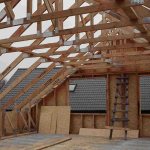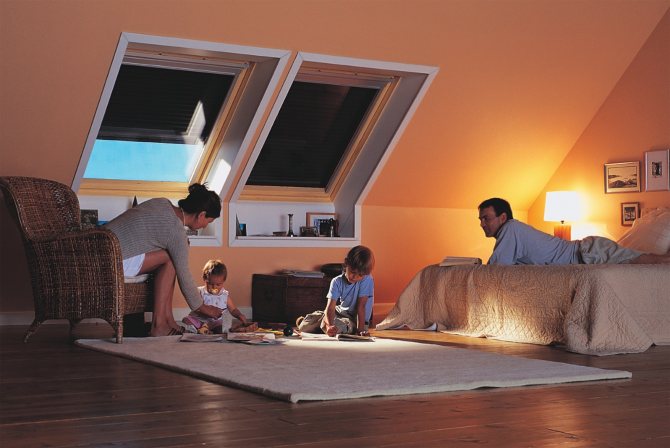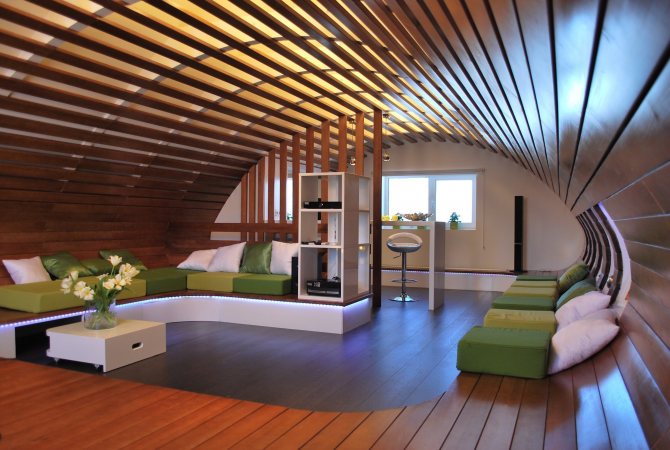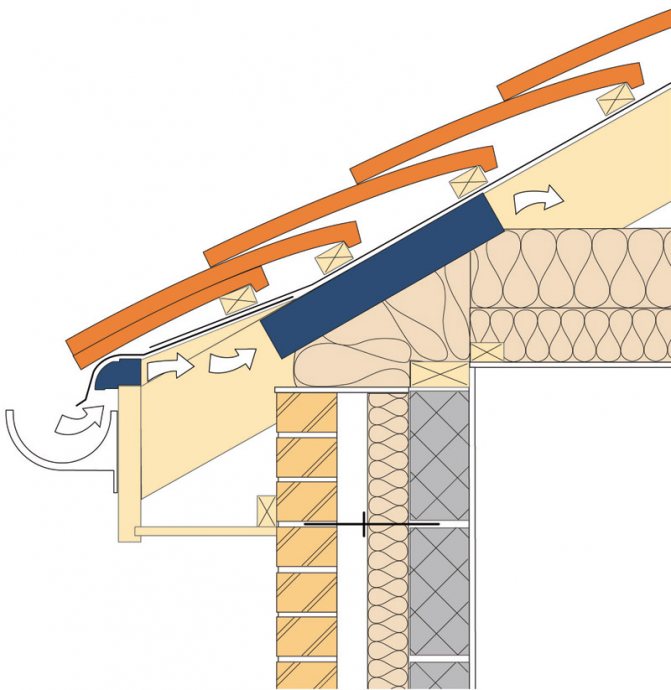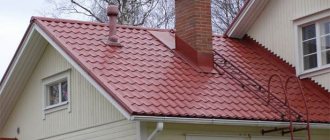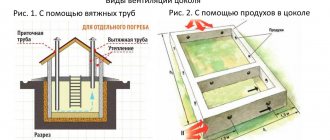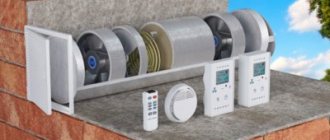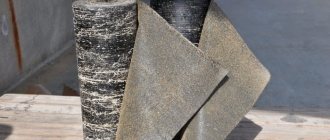Attic ventilation: an overview of current schemes and ways of their implementation
It is at least wasteful not to use a spacious attic as an additional room, and that is why ventilation of the under-roof space is so necessary
Planning to use your attic space as a living space, but don't know how to make it comfortable? I will talk about how the ventilation of the attic works. With a proper arrangement of the system for replacing stale air with fresh air, you can make the attic suitable for all-season comfortable living. In addition, the instructions for the installation of ventilation systems will be useful to you, even if the attic in a private house is not supposed to be used as housing.
Four reasons for ventilating attic spaces
An example of a ventilation device for supply and exhaust ventilation on a modern roof
- The comfort of living in the attic. Clean fresh air is one of the main conditions for comfortable living indoors. Therefore, if the room under the roof is used for living, you need to take care of the normal air exchange even at the design stage of the roof.
- Lack of condensation. Effective air exchange prevents condensation on the windows, which is important if the under-roof space is used as an attic.
- No mold. Timely replacement of warm humid air with fresh air prevents mold on building surfaces. That is, if the air does not stagnate in the attic, mold will not appear in the corners, no matter what materials are used for finishing.
- Long-lasting roofing resource. Excessive air humidity has a detrimental effect on the condition of the roofing material. Moreover, if moist air is not removed from under the roof, condensation will accumulate on the vapor barrier, which can reduce the resource of the insulation. A properly organized ventilation system will increase the life of the roof without the need for repairs.
Attic ventilation as it happens
The best option is a supply and exhaust system that works according to a natural principle, as shown in the diagram.
Under the eaves of the rafter roof, air vents are arranged through which the flow of fresh cold air is provided, while the warmer humid air will go into the skylights or other technological openings in the upper part of the gable or slope.
The preferred option when using modern roofing materials is a counter-grill with ventilation gaps. At the same time, air exchange in the insulated space of the attic is arranged separately, by means of a supply and exhaust system.
Keep in mind that ventilation in the attic must be planned and built as a complete system. That is, the project needs to provide for an air exchange system both in the attic and in the under-roof space, as well as pipe insulation and insulation of other communications. In addition, the ventilation design must be carried out taking into account the type of thermal insulation materials used.
Types of ventilation attic
The disadvantage of the system is the excessive dependence on the temperature outside the house. That is, in the warm season, ventilation will be weak.
The advantage of the forced system is that it does not depend on climatic conditions: the exhaust air will be removed with the same efficiency both in winter and in summer.
Methods for venting air to the outside
Under the ridge bar on a pie made of corrugated board or metal tile with their own hands, a vent is arranged, covered with a mesh. The ventilation device is such that the condensate formed in the cold season will not drain into the room, but will flow out onto the slope.
The peculiarity of the solution is that the windows are constantly open, regardless of the season. In order to prevent the entry of animals and birds, decorative grilles are installed over the windows.
The advantage of special aerators over a conventional pipe embedded in the roof is a special design that prevents the formation and penetration of condensate into the room.
There are manual and automated valves on sale.
Attic ventilation: an overview of current schemes and ways of their implementation
How to make ventilation in the attic? Read about the schemes and installation methods in the article
Attic ventilation: 4 basic solutions
It is obvious that effective air exchange is needed for a comfortable life in the house. Today we will talk about how to establish ventilation in the attic - a very specific area.
The attic - a room under the roof, receives warm and saturated with water vapor air from the lower rooms. It not only creates discomfort, but also poses a threat to the wooden structure of the roof and fiber insulation. When it enters a cold area (under the roof), the steam turns into condensation and moisturizes materials that do not tolerate water exposure. Therefore, an exhaust hood must be provided to remove moist warm air.
Air exchange can be natural (air moves by gravity due to traction) and forced (due to an electric fan).
There are four main ventilation solutions:
- with natural inflow and exhaust;
- with forced inflow and natural draft;
- with natural inflow and forced draft;
- with forced supply and exhaust.
The first option is the cheapest. In this case, a continuous supply of fresh air is provided by window or wall air inlets (valves). Built into the window, they ventilate the room when the sash is closed. Window valves are available for both conventional and dormer windows. Moreover, the attic can boast of labyrinthine channels, which exclude the formation of drafts. But their productivity is small - up to 30-50 m³ / h. There are also models with a vent valve combined with a handle for opening the sash.
But for the wall valve, you will have to make a hole in the outer wall. This device consists of an air duct with a diameter of 80–160 mm, an air intake grille, which is placed outside, and a head with an air flow regulator mounted from the inside. The principle of operation of the valve is different. For example, in humidity-controlled models, a moisture sensor in the room is connected to an external damper. It changes the flow area depending on the humidity level in the room, thereby controlling the air flow.
As for the hood, it is organized using ventilation ducts that are laid inside the building during the construction phase. The inlets are made under the ceiling, where heated air accumulates, and the outlet is on the roof.
It is recommended to make outlets of ventilation ducts as close to the ridge as possible. This is to improve traction.
The system with natural inflow and exhaust has a big drawback: it is effective only in the cold season. The fact is that air circulation requires a large difference between the temperature outside and in the building, which cannot be in the warmer months. The system with natural inflow and forced draft is devoid of this drawback. It assumes the use of the same supply valves (wall and window).However, the exhaust is carried out by mechanical fans built into the exhaust ducts. Let's consider them in more detail.
There are finished products - waterproofed outlets of ventilation pipes to the roof with a fan inserted into the head. There are also box-type exhaust fans with air capacity from 80 to 7000 m3 / h, mounted in "mini-attics". This means that they remain between the horizontal ceiling of the attic and the ridge of the roof. Moreover, the inlets are closed with grilles with adjustable dampers, which allows you to control the amount of warm air removed and thereby save heat. Such exhaust fans operate at low noise levels and are not audible in the living area. In addition, they have minimal power consumption, which means that their work will not cost a pretty penny.
Another option is the so-called hybrid ventilation. In this case, a mechanical low-pressure fan is installed on the natural exhaust ducts. In the cold season, it does not work, and its blades are designed so as not to interfere with natural thrust. However, in summer it turns on, maintaining a pressure in the channel comparable to natural draft.
Fully forced ventilation is an expensive solution and, according to many experts, is hardly justified in a country house.
At the end of the topic, we note that completely forced ventilation makes sense only when a country house is located near a busy highway or people with allergies live in it. In other cases, you can look for a compromise solution in order to breathe really clean air, and not the one that enters the rooms forcibly, passing through a mechanical fan (with lubrication), a filter (clogged with dust) and air ducts that are not distinguished by impeccable cleanliness.
Attic ventilation schemes and options
The specific type and scale of the ventilation system (more precisely, its selection) for the attic depends on several factors. When planning a diagram of how to make ventilation of the attic, the following factors must be taken into account:
- is it a residential attic or not;
- insulated or not;
- how often people will be there;
- what is its size (is it big or not).
There are no universal ways of organizing a ventilation system for an attic; in each case, one should proceed from the factors listed above.
Natural, with aerators
The effectiveness of the natural type of ventilation for the attic directly depends on how accurately ("according to the textbook") the insulation materials were installed. The main and mandatory rule for laying insulation materials is to leave ventilation spaces in the interlayer segments of the material used and directly in the under-roof area.
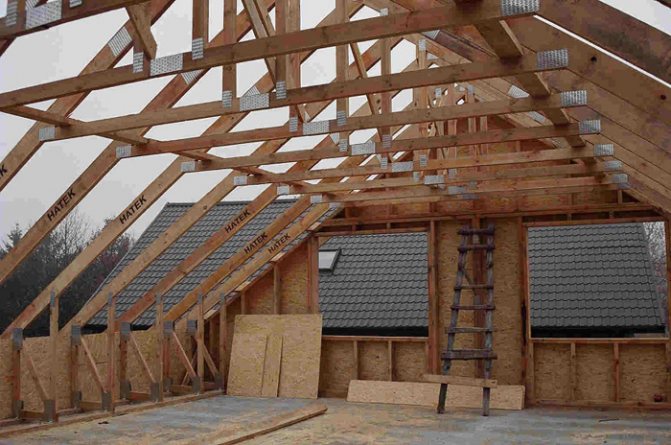
It is necessary to do ventilation of the attic even at the stage of roof construction.
Simply put, there should be a free ventilation space both between each layer of the applied insulation, and directly under the surface of the building's roof. The mechanism of operation of natural ventilation is based on natural (which is natural) draft.
Natural draft easily provides a constant supply of fresh air from the outside. In this case, the total area of ventilation ducts should be about 0.2% of the entire area of the attic. In most cases, it is advisable to use the ventilation installation option, in which the outlet of the ventilation ducts is carried out through the gables.
Natural with dormer windows
When implementing this ventilation method and installing dormer windows, one should be guided by the standards prescribed in SNiP 2-26 and SNiP 21-01. These standards state:
- installation of dormer windows is allowed only with a roof slope of at least 35 degrees;
- the minimum dimensions of the flaps should be 0.6x0.8 meters;
- the regulated dimensions of the dormer windows are 1.2x0.8 meters.
The shape of dormer windows installed in a private building can be of a wide variety of shapes, and ultimately depend on the general style of construction. Installation of skylights is carried out using frames at the stage of roof construction, together making up a single structure.
The ventilation system based on the use of skylights significantly improves the aesthetic appearance of the roof and also improves its basic functionality. In most cases, for a pitched roof, the best option would be to use windows with 1 inclined plane.
The installation scheme is quite simple: 2 beams are attached at the distance required by the regulations and then fixed by means of vertical posts, which are joined at the top with a jumper. Then the outer sides should be sheathed with cladding, and at the end, a decorative (with any style at the discretion of the building owners) grille is mounted on the side of the facade.
Forced, with an exhaust fan
Given the relatively small area of the vast majority of attics, they do not need a forced flow. In about 95-99% of cases, it will be sufficient to install a forced exhaust system.
How to make an inflow depends on a number of circumstances, but in most cases the classic scheme is suitable. In the classical scheme, the supply system is organized through gaps, windows (due to micro-ventilation or simply opening a window, through a comb), window valves, or through the air duct system, if any.
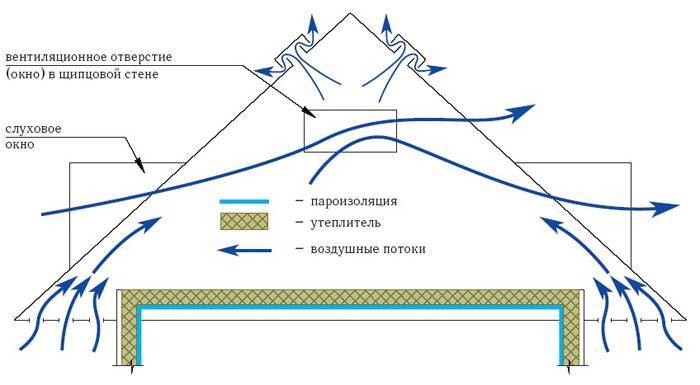

Attic ventilation system diagram
Two options for the device of natural ventilation of the attic and upper floors of the house
Option one. Attic ventilation with an entrance door to the floor
At the entrance from the stairs to the attic and to all upper floors (2nd floor and above), install the entrance door, which blocks the air flow from the lower floors and divides, isolates the air space of the floors into independent blocks.
In this version, natural ventilation on the upper floor is performed in the same way as on the first floor of the house.
Ventilation scheme for the attic floor and other floors of a multi-storey building with entrance doors on each floor.
In the diagram: 1 — inflow of fresh air into the rooms from the street through the inlet valve in the window or in the wall; 2 — overflow of air from rooms through a corridor or hallway to a bathroom, kitchen through overflow grates or slots; 3 — air extraction into the natural ventilation duct.
In the living rooms of each floor, supply valves are installed, and exhaust ducts are made from a sanitary room, a dressing room, and in their absence, from a hall. To move air between the rooms of the floor, ventilation overflow slots are left at the doorstep in the doors of rooms and bathrooms, or overflow grilles are installed in the doors.
For the ventilation to work properly, the entrance door to the upper floor must always be in a closed position. The front door to the floor should be as tight as possible. Care should be taken to seal other paths for air movement between floors - floors, places of passage of communications.
The option described above with an entrance door to the floor provides most efficient operation and simplest device
natural ventilation of the attic and upper floors of the house.
Second option. Attic ventilation without an entrance door to the floor
There are options for planning the interior space of a private house, when the entrance door from the stairs to the floor is not made.
In this case, it is necessary to allocate and isolate the air space not on the floor as a whole, but for each room separately. For this, sealed doors are installed in each room of the floor, without overflow slots and gratings.
In each room of the attic and upper floor
for the supply of fresh air, a supply valve is installed. To remove contaminated air
arrange a channel of natural ventilation, and also from each room.
For normal ventilation, the doors of the rooms should be kept closed at all times.
The second ventilation option for the upper floors is not convenient
the fact that it is necessary to increase the number of natural ventilation channels. Although the ventilation channels can be combined, the ventilation system is still quite complex.
In both cases, it should be borne in mind that it is not possible to completely block the air flow to the upper floors from below. Therefore, it is recommended to increase the volume of exhaust air through the ventilation ducts of the upper floors.
On the upper floors, the height of the natural ventilation channels is less, which means that the amount of draft in them is noticeably lower than in the channels on the lower floor. On the very top floor of a house, natural ventilation often fails to provide the required air exchange.
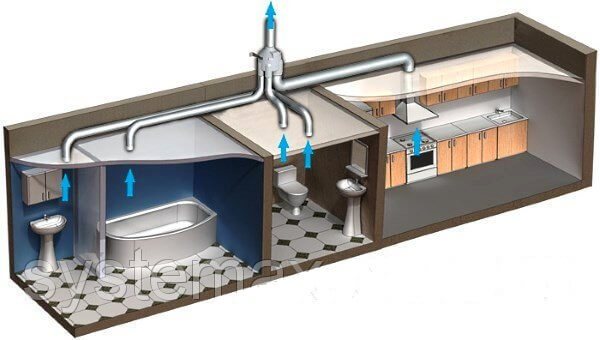

An example of a device for exhaust forced ventilation of the attic or upper floor, using a single duct multi-zone fan
In the attic, and often on the upper floor of the house, the height of the vertical ventilation ducts is so low that the draft in the duct cannot provide the normative value of the natural ventilation capacity.
It is not always possible and advisable to increase the height and cross-section of natural ventilation channels in the attic. In many cases in the attic and upper floor of the house, forced exhaust ventilation is required for normal ventilation.
Roof ventilation in a cold attic
In any room where there is no ventilation, a normal microclimate is impossible. Insufficient air exchange is the cause of stagnant air and high humidity, at the next stage, mold begins to grow on the structural elements and fungus starts. All these factors negatively affect the structure, over time it will begin to deform and lose its purpose. In a private house, the room under the roof can be warm or cold.
Differences between cold and warm roof ventilation
In the first case, the ventilation duct is equipped over the entire area of the slope with the help of a lathing and counter-lathing. Warm air masses enter the under-roof space at the eaves, rise and exit through the aerator in the roof strip. Condensation also leaves through it.
Many owners of private houses, where the premises under the roof are not heated, wonder if roof ventilation is needed in a cold attic, because no one lives there? Such a system should be in this case as well, since it will ensure the safety of the structure itself.
Only for an unheated room, it is arranged differently. In this case, air vents are created in the under-roof cornice for the flow of cold air, while warm air goes into the aerator and dormer windows in the attic in a private house.
Arrangement of roof ventilation for a cold attic
For an attic space, this is the level of the cornice. Holes need to be created here
It is very important to correctly calculate the size of the vents in the attic, so that the air inflow and outflow are the same. Often, owners of private houses use perforated spotlights.
To create an outflow of air from the attic, there are roofing elements such as aerators and a ridge. The direction of movement of streams is formed depending on the characteristics of a particular house:
- if the roof of the house has two slopes, ventilation ducts are made on the gables - loose overhangs or holes in the wall, the area of the channels should be 0.2% of the area of the attic,
- if slate or ondulin is used as a roofing material and no vapor barrier was used, then no additional structures are needed, since air will circulate along the waves of the coating, the ridge will serve as an outflow element,
- if the roof of the house is flexible or made of ceramics, a "turtle" (valve) is formed,
- a system of two grids has proven itself well, one is installed with holes in the downward direction, the other can be adjusted,
- on the hip roof, ventilation can be created using two holes, one of which is located at the bottom at the hem, the other at the ridge at the top,
- also on a hip roof, provided that the overhangs are wooden, you can place beams with a gap of several millimeters.
Sequence of work
- Calculation of air exchange According to SNiP, in cold attics, as in basements, dormer windows or vents are needed for air flow. In total, their area should be 1/400 of the total area of the room.
- The choice of the system of outflow and air inflow. After performing the calculations, you need to choose the system that will be optimal for your home: an aerator or a ridge, windows or air vents. Next, a diagram is drawn up, that is, how many ventilation elements there will be, their sizes, how they will be located.
- Execution of work. When creating a ventilation system in the attic, you should strictly adhere to the scheme.
Let's summarize
From the foregoing, it is clear that the work is not difficult for a home craftsman who knows how to hold a tool in his hands and accurately follow the recommendations of the project. But nevertheless, it is better to entrust the development of documentation to specialists. They will calculate the size of the air vents in the attic, their location and number, according to the characteristics of a particular room. A professionally created project will save you from mistakes and shortcomings, the consequences of which can be dire.
Roof ventilation in a cold attic
The need to create effective roof ventilation in a cold attic is associated with the formation of the required level of comfort in living quarters. Otherwise, heat loss and the formation of condensation are inevitable, and then the appearance of mold and mildew, and even deformation of the house.
The subtleties of designing ventilation in the attic
Before installing aerators or mechanical hoods in the attic, careful thought and selection of the best option is necessary. The area of the room and its purpose are taken into account.
Design
Design is of the utmost importance in the arrangement of ventilation. It is performed even during construction work in order to avoid additional costs. Even if the construction has already been completed, and ventilation has not been done, it is better to equip it right away so as not to wait for future problems when the attic becomes unusable.
Regardless of the location of the entrance to the attic room, inside or outside the building, ventilation will be required in any case.
How to properly design ventilation
First of all, they provide for the possibility of an inflow of fresh air. This is influenced by the implementation of the correct roof structure for the device of one ventilation gap provided by the counter-lattice. It is sometimes used not solid, but discontinuous (in separate segments).
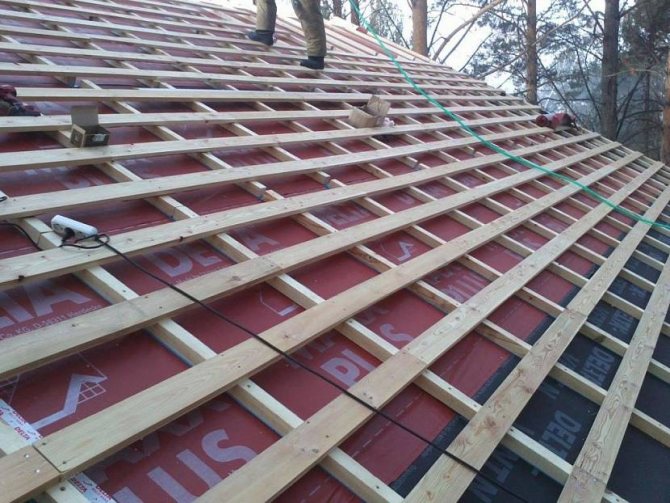

It looks like a counter lattice made of wood Source kabanchik.ua
The next element of the constant flow of fresh air is the soffits under the eaves. In this case, the diffusion or microperforated film is not brought to the edge of the cornice, it ends immediately behind the wall for the free passage of fresh air masses.
Another way to bring in fresh air is a gap around the entire perimeter of the roof between the waterproofing and the roof itself. The size of the interval of 3-5 cm must be observed throughout the entire length, as well as when entering and leaving. This rule is observed with insulated roofing systems that do not have insulation.
Having designed the air inflow, the development of the optimal outflow option begins:
- upper roof section equipped with ventilation ducts, point aerators, aeration turbines operating with the smallest gust of wind;
- waterproofing film along the entire length along the ridge girder, and perform a gap for an easy outflow of air from under the roof;
- if a long meal (inner corner), then the air flow is provided along the entire line to the ventilation gap, arranging a continuous ventilation junction
- also settles continuous ventilation ridges (connecting elements of the roof slope) and ridges (intersections of two roof slopes).
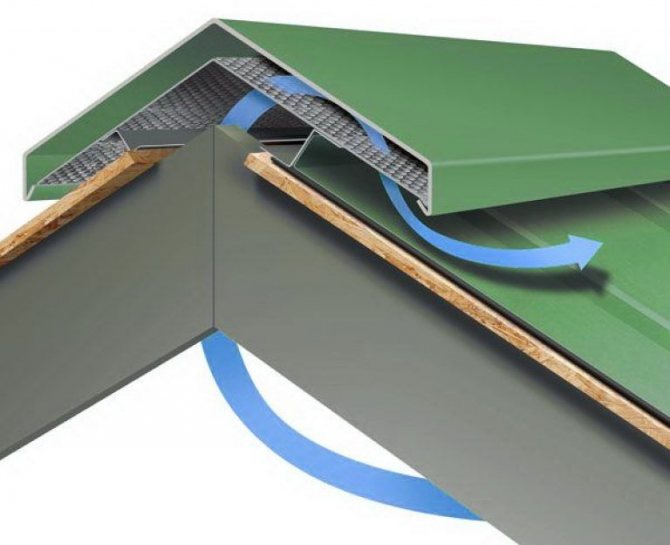

Passage of air through the ridge Source proroofer.ru
It is possible to calculate all the necessary ventilation elements, their number, only depending on the area of your attic. All calculations are individual, because all buildings have a different shape of the roof, which is of great importance for the design of ventilation in the attic.
Roof ventilation purpose
Roof ventilation is designed to remove moisture from the space located between the outer moisture-proof material: tiles, corrugated board, slate, and internal roof structures.
The main functions that it performs:
- preventing the accumulation of unventilated air under the roof. This is especially true for houses with residential attics,
- elimination of the formation of frost and ice in the under-roof cavities,
- timely removal of moisture and dampness from the attic space.
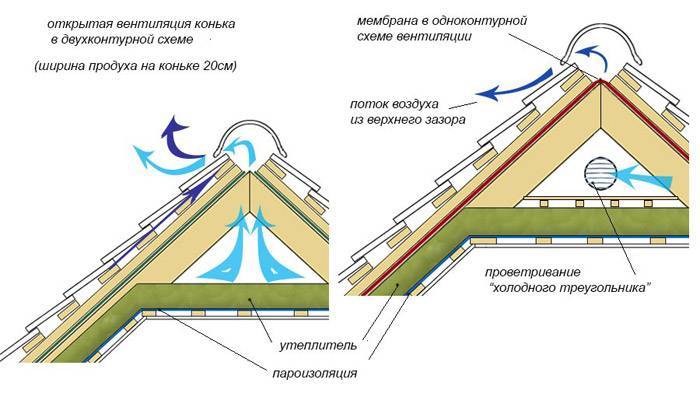

The need to install roof ventilation systems is caused by fluctuations in daily air temperatures, as a result of which condensation forms on the inside of the roof: in the winter in the form of frost, and in the summer - dampness.
This problem can be partially solved thanks to the device of the so-called "roofing cake", which includes a layer of steam and waterproofing. However, waterproofing layers cannot always and everywhere prevent the accumulation of dampness under the roof.
Moisture formed inside the "roofing cake" leads to a sharp drop in the efficiency of its work. Since mineral wool slabs are usually used as insulation, they become denser under the influence of dampness and lose their thermal insulation properties. In winter, moisture accumulating under the roof turns into ice and, expanding, gradually destroys the attic structures. During the warmer months, dampness leads to the formation of mold and mildew, which can spread to the entire building.
All these problems can be eliminated by roof ventilation.
Device
With a cold roof
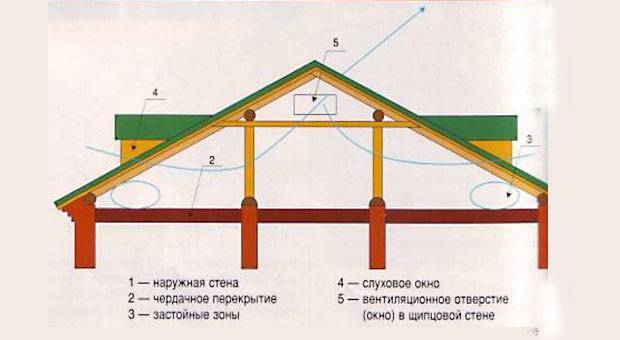

This is the easiest way to solve the problem, since the attic space allows large volumes of air to move freely. Air vents located under the eaves, under the ridge strip, in the gables allow air masses to circulate due to natural convection:
- cold air is drawn into the attic from the outside through the eaves vents;
- warm air rises from the ceiling of the dwelling up under the roof and goes out through the ridge vents.
Of course, in this way it is impossible to completely level the temperature difference of the roof surface from the outside and inside, however, usually it is not enough for the formation of condensation on the inside of the attic.
As a rule, the number of vents located at the top and bottom of the slope of pitched roofs of a simple configuration is the same. The only condition under which normal circulation of the air flow is ensured is that the total area of the vents should be about 0.33% or ⅟300 of the slope area.
For a warm roof
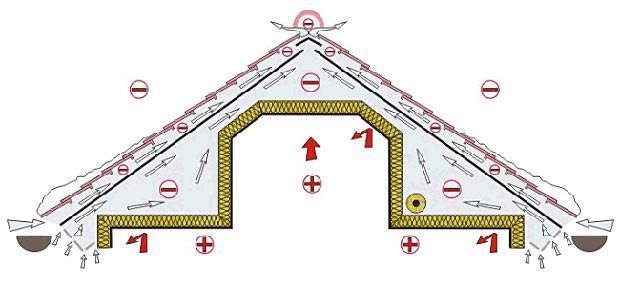

Attic ventilation is somewhat more complicated. In such a design, air cannot circulate freely, since it is almost entirely occupied by attic rooms.
Air circulation in the residential attic located in the under-roof space is provided by a convective flow directed from the eaves towards the ridge.In order for it to pass this path unhindered, additional space is created in the roofing pie between the layers of thermal and waterproofing using a counter-lattice and lathing. The gap must be at least 5 cm high.


Then, in the space under the roof, a ventilated circuit is formed, that is, they provide the flow of air, as well as its exit with vapors:
- inflow: eaves overhang along the bottom of the roof, then, attic windows (above them), valley or others, where the contour is interrupted;
- exit: ridge, attic windows (under them), junctions, that is, where they need to be made on purpose.
Attention! It is important to ensure the continuity of the circuit in order to exclude the formation of "stagnant zones", places of possible accumulation of condensate
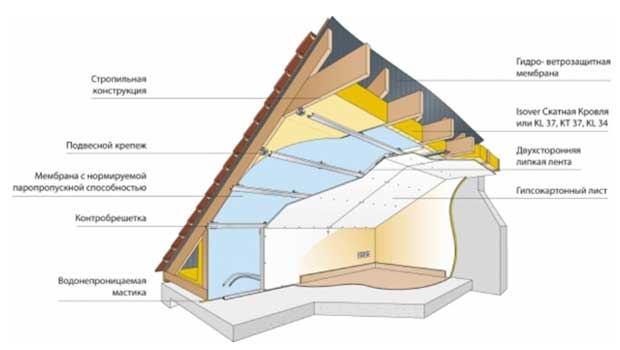

attic ventilation
Ventilation system functions
Outlets for extractor hoods and household ventilation effectively remove exhaust air from the premises to the street.
- Removal of vapors entering the attic / attic from the lower floors.
- Prevention of condensation from attic / mansard air on the inner surface of the roof.
- Reducing the effect of solar heat. Correctly installed ventilation will reduce the heating of the air under the roof. At the same time, a comfortable microclimate is organized throughout the house.
- Prevention of ice formation on eaves and overhangs.
An attic without attic equipment is ventilated through roof gaps. There is a natural circulation of air currents. Vapors escape from the building through the ridge vents, and a cold air stream is drawn in through the cornice vents. A simple pitched roof requires the same number of ridge and cornice vents. The total area of the air gaps should be 1/300 of the area of the roof slopes.
Mansard roof ventilation system
In mansard roofs, the ventilation system is arranged between the layers of the roof, which are conventionally called "roofing pie":
- vapor barrier membrane or film (the lower the vapor permeability of the film, the better);
- insulation (fits between the rafters);
- lathing;
- counter-lattice made of bars or slats;
- waterproofing membrane or film;
- roofing material.
The waterproofing film / membrane protects against moisture from the outside, the vapor barrier film / membrane protects against internal moisture. When installing such a double-circuit insulation, an upper (in the ridge zone) and lower (in the cornice zone) air outlet / inlet is provided.
The upper ventilation vent is arranged between the roof and the waterproofing coating: moisture that gets under the roof from the outside is dried through it. With an upper clearance, all truss structures will be well ventilated.
The lower ventilation outlet is arranged between the insulation and the waterproofing; through it, moisture will be removed, entering the insulation material from the interior. Warm air has a high moisture content, so it needs to be equipped with an outlet to the outside.
Roof ventilation from metal tiles and corrugated board
If the builders are conscientious, then under the corrugated board (metal tile) they had to lay waterproofing - some kind of appropriate roll material. For what? In cold weather, condensation forms on the inside of the metal, which flows in real streams ... guess where. In addition, moisture can penetrate through the roofing material itself and also flow to the ceiling. In addition, steam penetrates through the ceiling and condenses on the metal tile / corrugated board and also flows down - not like steam, but like water ...
So: we put waterproofing under the metal roofing materials, and ventilation should be carried out between the roofing material and the waterproofing membrane so that moisture can quickly be removed from the waterproofing surface.
It is technically simple to make roof ventilation from corrugated board or metal tile: using a counter-lattice:
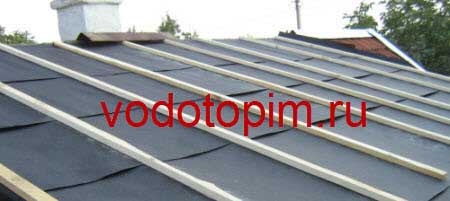

The counter-lattice is a slats of 25x50 mm, attached over the waterproofing to the rafters. The counter-lattice also provides the gap necessary for ventilation of the roof.
It is necessary to lay waterproofing under the corrugated board or metal tile, even if the attic is not planned to be made warm, that is, insulation will not be laid between the rafters. And you also need to make a counter-lattice. And in the presence of a warm (residential) attic or attic, ventilation of the roof in the manner discussed above is especially important.
Ventilation between roof layers
The layers of the roofing structure should be arranged in a specific sequence.
1. If you move from the side of the room, then a vapor barrier follows the cladding layer. It is nailed to the rafters, lined with slats from below.
2. The vapor barrier material is followed by a layer of insulation between the rafters.
3. Then comes the counter-lattice and the lathing.
4. After them a layer of waterproofing. In this case, a ventilation gap is formed between the thermal insulation and the waterproofing, where air circulates freely. Bars are stuffed onto the rafters, if necessary, so that the gap is sufficient.
5. Then the layer of roofing material is fixed. There should also be a ventilated gap between it and the waterproofing.
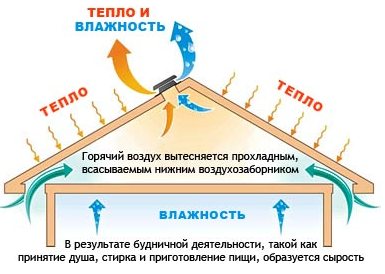

The general principle of roof ventilation in one picture
How to make ventilation attic in a private house
At the design stage of the future home, it is important to think not only about the convenient layout of the premises.
Coziness in the house cannot be provided for a long time if you do not pay attention to such an important point as the ventilation of the attic in a private house
This is no less important than the insulation of the attic, because the lack of well-designed ventilation will lead to the fact that living in the house will soon be uncomfortable, and the service life of the house will be drastically reduced.
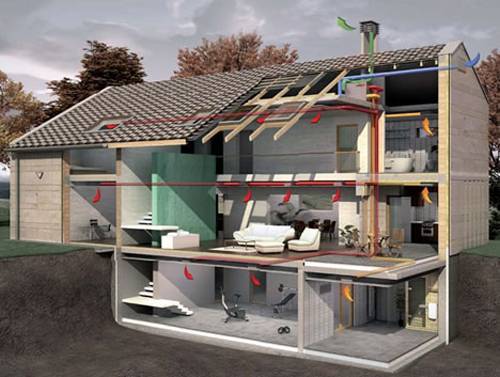

The lack of ventilation can lead to a reduction in the life of the roof due to the appearance of mold on it, and in the house itself you can not hope for a comfortable stay. In summer, when the roof heats up and its temperature becomes more than 100 degrees, it will be very hot in the house, and at low temperatures, condensation will form in the attic. due to which wooden roof structures will rot.
The main purpose of the ventilation system is to provide heat exchange. The temperature of the air and the roof mix, and as a result, a comfortable microclimate is created in the house.
Let us consider in more detail the situation when the ventilation of the attic is bad, or there is none at all.
In winter, part of the heat from the room still leaves even through a high-quality insulation. At the same time, the roof heats up, and unevenly, only above the room. Here the snow begins to melt and flows down to the edge of the roof, where it remains cold above the overhang. Ice that forms on the eaves of the roof does not allow melted snow to drain, and it begins to penetrate under the roof. To prevent this from happening, it is necessary to ensure that the temperature throughout the roof is leveled and moisture is removed - for this, ventilation of the attic is needed.
What is ventilation in the attic and why is it needed
Air exchange in the under-roof space is important at any time of the year. In the summer, ventilation helps to avoid overheating of the house from the hot roof covering, especially if the latter is made of metal materials.
In winter, warmth and moisture emanating from the house contribute to the formation of frost and, as a result, dampness. This problem cannot be avoided without intensive ventilation.
If, in addition to the lack of ventilation, the heat-insulating layer is not properly made, in winter the roof can heat up to positive temperatures, leading to thawing of the lower layer of snow and the formation of an ice crust and icicles during the thaw period.
Without air exchange in the space under the roof, the microclimate throughout the house is disturbed: on sunny summer days, living quarters will quickly heat up, and from autumn to spring, condensation will accumulate under the sheathing. Accordingly, without the release of steam, which is formed as a result of the vital activity of the inhabitants of the house, the humidity will increase in the rooms as well.
But the main danger of the lack of air exchange is that the wooden elements of the roof will wear out much faster than the time allotted to them. Moisture contributes to the accelerated process of decay, fungal and mold damage.
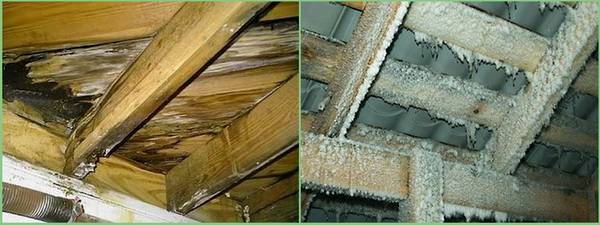

Therefore, ventilation of the roof space is indispensable.
In addition, it is important that the air exchange is efficient. What you need to consider when arranging ventilation in the attic:
- The area of the holes should correspond to the area of the attic. The ideal ratio is 1 to 500 (1 square meter of ventilation per 500 square meters of space).
- The entire internal space of the roof must be involved in the air exchange. If the air stagnates in some areas, condensation or frost will form.
- The ventilation system should have two channels: through one air enters, through the other it goes out into the street.
The most difficult stage of the work is the calculations. Too many or too large air vents are just as bad as insufficient air space. This task is best left to specialists.
Is ventilation of the attic floor necessary, and why
It is imperative to equip a ventilation system in the attic space, since it allows you to solve several very serious problems with the microclimate at once. At the same time, you can equip it with your own hands with a relatively small budget for work.
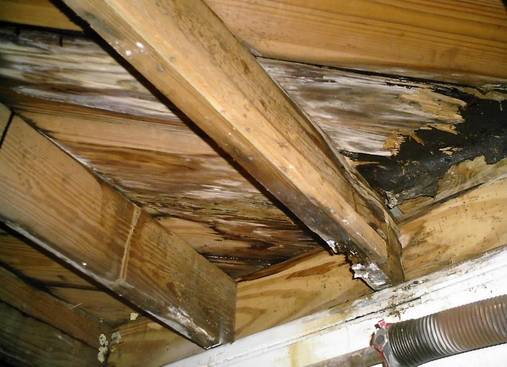

Consequences of lack of ventilation in the attic
Properly done attic ventilation solves the following problems:
- Elimination of excess moisture and prevention of dampness in heat-insulating (insulation) materials. That is, ventilation protects thermal insulation materials from wear and tear and functional damage.
- A significant reduction in the likelihood of the appearance and accumulation of colonies of fungi and mold, which creates additional protection for wooden roofing items (and also protects the health of those living in the building).
- Protection against the drift of too hot air masses into the building during periods of intense heat (heat) in the external environment (outside).
- Protection against moisture accumulation, and, as a result, protection of corrosive phenomena that can damage metal structures.
- Protection against the appearance of icicles under the eaves in winter (especially in severe frosts).
- Significant savings in electricity required for optimal heating of the attic for the winter and, sometimes, autumn periods (in general, during the cold season).
Exhaust ventilation type
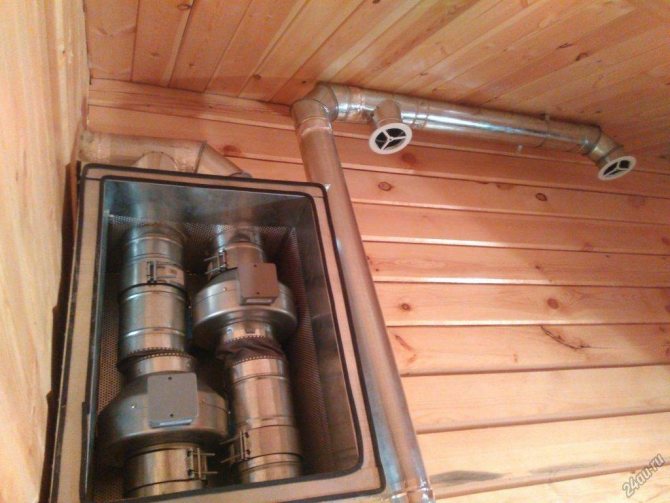

A positive answer to the question whether ventilation is needed in a wooden house is based on many years of experience in the construction and operation of private households. The organization of the air flow is the basis of the principles of exhaust ventilation. The air intake must be unimpeded. Naturally supplied ventilation supplies the house with air from the street. Main advantages:
- profitability;
- simplicity of the ventilation system design;
- availability.
Exhaust ventilation in a private wooden house is provided at the design stage. It is a central highway with branches, which are designed to ensure the outflow of air from all rooms of the house. To increase the efficiency of operation, the exhaust ventilation is equipped with fans mounted at the inlets of the ventilation ducts. The power of the fans is different, therefore it is selected based on the volume of the room. Fans are economical, there are models with automatic operating modes.
Ventilation system installation
Before starting the installation of the ventilation system of the attic rooms, it is required to make a project and calculate all the necessary parameters.
At the same time, at the design stage, the entire attic of a residential building should be carefully measured and all important dimensions and parameters required for the calculation and installation of the ventilation system should be recorded.
If the choice fell on a forced-type system, it is important to choose a fan of the appropriate power. During installation, you should adhere to a certain order of actions:
During installation, you should adhere to a certain order of actions:
Referring to the diagram, mark all ventilation elements, including valves and a chimney. Make holes in the roof using a special tool. For supply valves, through holes must be made in the cornice or pediment
It is important to take into account that the supply valves are located below the exhaust valves. Install the required valves. The slots must be sealed. A pipe cover is installed on the roof and is firmly fixed
Before installing the pipe itself, you need to make sure that all joints are reliably sealed. The pipe must be installed strictly in a vertical position, taking into account all the required distances. Inside the room, a fan is mounted on the pipe, and a deflector is installed outside. The system can then be used.
A test for air exchange in the room is carried out for several days.
Correct installation of ventilation will ensure the most efficient supply of fresh air, and optimal removal of exhaust air. Any violations during the installation of the structure will significantly reduce the efficiency.
Natural ventilation in the attic
The natural ventilation system directly depends on the correct installation of the insulating materials. A prerequisite for laying insulation is the presence of ventilation spaces between the layers of the material used and under the roof surface. Natural ventilation is based on the creation of natural draft, due to which there is a constant flow of air masses. The total area of the ventilation ducts should be 0.2% of the total area of the attic. The simplest installation option is to output the channels through the gables. This technology can be applied to a non-stone roof element.
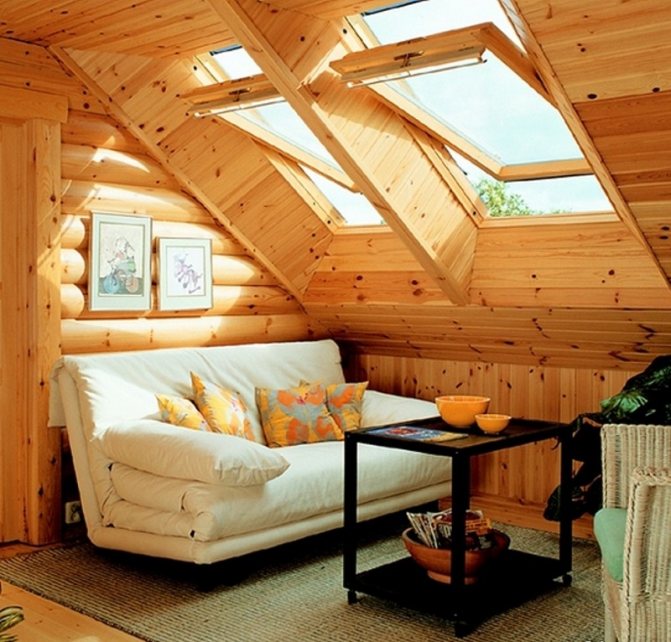

Under-roof natural ventilation option
The size of the gap for free air exchange depends on the roofing material used for the roof:
- when using metal tiles, tiles, metal profiles, the gap should be more than 25 mm;
- when using soft materials and flat products, the space for air flow should be more than 50 mm;
- when installing waterproofing and insulation, the space between them should be from 20 to 30 mm.
Important! To create high-quality natural ventilation over the attic room, it is necessary to create a hermetic separation of the ventilation cavities, due to which the natural ventilation of the attic floor will be carried out evenly, without the formation of "dead" zones.
DIY installation
Before you start arranging the ventilation of the attic with your own hands, you need to create its project, carefully think over the layout of the components included in it, write down the sequence of work on paper. In the process of preparation, it is imperative to inspect all sections of the attic room, make the necessary measurements, and note the design features of the attic. When performing forced ventilation, it is necessary to select an exhaust fan with the appropriate technical characteristics. The sequence of installation work:
- On the diagram, according to the established designations, the fixing points of the valves and the section for laying the exhaust pipe are marked.
- In the roof, you need to drill holes with a drill or punch.These works are carried out very carefully so as not to damage the layers of the roofing cake, the construction of which includes a roof covering, lathing, waterproofing, insulation and vapor barrier layers. Openings for supply valves are made in the cornice or pediment. Be sure to consider the placement of the supply and exhaust ducts. The first ones are equipped below.
- The valves are being installed in the wall. A tube is inserted into the pre-drilled hole, which is closed by a grill from the street side. A filter is installed on the inside and the valve body is attached. All these items are included with the valve. The gaps between the structural elements and the wall surface are carefully sealed.
- On the surface of the roof, where the hole for the pipe is drilled, the overlay is securely fixed, the quality of the sealing of the connecting sections is checked. Next, the pipe is installed strictly vertically. It is imperative to maintain all calculated distances.
- From the inside of the building, a fan is mounted to the pipe, and from the outside, a deflector. The ventilation system is ready for use. The effectiveness of its work is tested for several days.
It is important to understand that properly equipped mansard roof ventilation is one of the conditions for comfortable living in a country house. When arranging it with your own hands, it is imperative to comply with the established building codes, design together with the structure of the house and equip it at the stage of erecting the roof of the building .. https://www.youtube.com/embed/VGCQE8ZgaSE
Attic ventilation functions
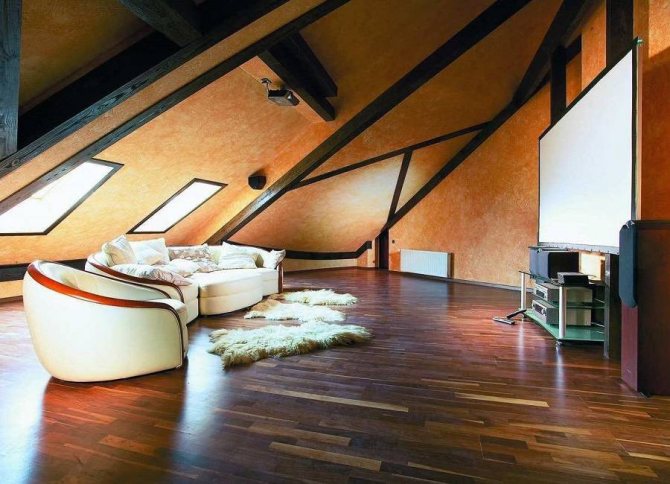

A living attic cannot be without good air exchange
The ventilation system during a particularly hot period allows you to eliminate stuffiness, but in winter it effectively prevents cold and moisture from entering the room. That is why an important point is the correct installation of the ventilation system with your own hands, because:
- the system removes moisture and prevents the formation of dampness in the insulation material - it is thanks to ventilation that the heat insulator retains its functionality for many years, preventing the penetration of heat and cold;
- with properly created ventilation, the formation of fungus and mold is minimized, thereby eliminating the possibility of premature destruction of wooden roof elements;
- in extreme heat, it prevents hot air from entering the house;
- prevents the accumulation of moisture, thereby preventing corrosive manifestations that negatively affect the metal tile;
- eliminates the formation of icicles under the eaves in severe frosts;
- saves energy, thereby reducing the costs required to heat a residential attic in the winter.
Ventilation for wardrobes and closets
Ventilation must be done in the dressing room, pantry. Without ventilation, rooms will smell, humidity will rise, and even condensation, fungus and mold may appear on the walls.
The natural ventilation scheme of these rooms should exclude the flow of air from the dressing room or pantry into the living rooms.
If the doors of these premises open onto a corridor, hallway or kitchen, then the premises are ventilated in the same way as living rooms in a house are ventilated. For the flow of fresh air from the street, a supply valve is placed in the window (if any) or in the wall. In the door of the dressing room, pantry, a gap is left at the bottom, between the door and the floor, or another hole is made for the passage of air, for example, a ventilation grill is inserted into the lower part of the door.
Fresh air enters the dressing room or storage room through the supply valve, then leaves through the opening in the door into the corridor, and then goes to the kitchen, into the exhaust duct of the natural ventilation of the house.
Between the dressing room or storage room and the room where there is a natural ventilation channel there should be more than two doors.
If the doors of the dressing room open into the living room, then the air movement for ventilation of the dressing room should be organized in the opposite direction - from the living room, through the opening in the door, into the ventilation duct of the dressing room. In this variant the dressing room is equipped with a natural ventilation channel.
How to make forced ventilation in a private house, read the next article.
More articles on this topic:
⇒ Natural ventilation system in a private house - diagram, device, features ⇒ How to properly make natural ventilation in a private house
⇆
More articles on this topic
- Films and membranes for waterproofing, vapor barrier and wind protection at home
- Broken roof of a house with an attic with your own hands
- Build a house with one floor or two?
- What area of premises to choose for building a house
- Prefabricated dry floor screed made of sheets of gypsum fiber board, chipboard, OSB, plywood
- Visor, outer door canopy
- Finishing, cladding the walls of the house with vinyl siding
- How to properly insulate the attic
